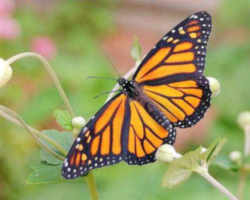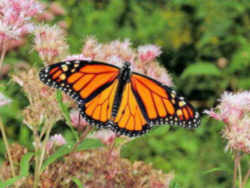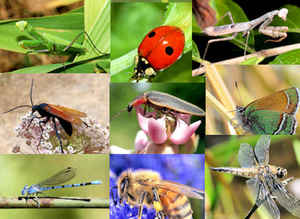Idaho State Insect
Monarch Butterfly

(Danaus plexippus)
Adopted in 1992.
The Monarch Butterfly, (Danaus plexippus,) was adopted as the state insect by the state legislature in 1992. Both the caterpillar and adult monarch butterfly are brilliant in color as a warning to predators - the monarch ingests toxins from the milkweed plant which are poisonous.
Early settlers to North America from Europe, particularly those from Holland and England, named the butterfly 'Monarch,' after King William, Prince of Orange, state holder of Holland and later named King of England. The monarchs' color suggested the name. The Monarch Butterfly is a great migrator, traveling many miles during its lifetime, which can be from a few weeks up to a year. Monarchs range in mass from .25 to .75 grams (a dime has a mass of 2.3 grams). Males are usually larger than females. Female Monarchs lay eggs on the underside of milkweed plants. The larvae then feed on the plants. Monarchs go through a complete metamorphosis in 3 to 6 weeks.
Did you know that: The Monarch Butterfly has been proclaimed the official state insect or butterfly in each of the following states:
Minnesota | Texas | Vermont | West Virginia
Idaho State Insect: Monarch Butterfly

The monarch butterfly is sometimes called the "milkweed butterfly" because its larvae eat the plant. In fact, milkweed is the only thing the larvae can eat! If you'd like to attract monarchs to your garden, you can try planting milkweed (if you live in the right area).
Entomologists divide the migrating populations of Monarch Butterflies into two groups, one west of the continental divide which is considered too high for the butterflies to fly over, and all the territory eastward including Florida. The eastern and western migrating Monarch undergoes a chemical change delaying sexual maturity, allowing the butterflies to wait out the winter in large colonies south of the freeze line which have been found in Mexico and California. They only mate when they return north, living as long as nine months in the process.
Characteristics of the Monarch Butterfly
In Spring when the female butterflies migrate northward, they lay eggs on various species of milkweed. The development period from the egg through larva and chrysalis to the adult ranges from 20 to 33 days. The development time depends on temperature (faster in warmer areas). Some monarchs remain in the vicinity of their breeding grounds; others fly north to lay eggs. Some monarchs remain in the vicinity of their breeding grounds; others fly north to lay eggs.
The development period from the egg through larva and chrysalis to the adult ranges from 20 to 33 days. The development time depends on temperature (faster in warmer areas).
The larvae feed on the plant leaves for about two weeks and develop into caterpillars about 2 inches long.
After awhile, the caterpillars attach themselves head down to a convenient twig, they shed their outer skin and begin the transformation into a
pupa (or chrysalis), a process which is completed in a matter of hours.
The pupa resembles a waxy, jade vase and becomes increasingly transparent as the process progresses. The caterpillar completes the miraculous transformation
into a beautiful adult butterfly in about two weeks.
The butterfly finally emerges from the now transparent chrysalis.
It inflates its wings with a pool of blood it has stored in its abdomen. When this is done, the monarch expels any excess fluid and rests.
The butterfly waits until its wings stiffen and dry before it flies away to start the cycle of life all over again.
Eastern populations winter in Florida, along the coast of Texas, and in Mexico, and return to the north in spring. Monarch butterflies follow the same migration patterns every year. During migration, huge numbers of butterflies can be seen gathered together.
Most predators have learned that the monarch butterfly makes a poisonous snack. The toxins from the monarch's milkweed diet have given the butterfly this defense. In either the caterpillar or butterfly stage the monarch needs no camouflage because it takes in toxins from the milkweed and is poisonous to predators. Many animals advertise their poisonous nature with bright colors... just like the monarch!
Idaho Law
The law designating the monarch butterfly as the official Idaho state insect is found in the Idaho Statutes, Title 67, Chapter 45, Section 67-4509
STATE GOVERNMENT AND STATE AFFAIRS
CHAPTER 45
67-4509. STATE INSECT DESIGNATED. The monarch butterfly is designated and
declared to be the state insect of Idaho.
STATE INSECT
Idaho Session Laws, 1992, page 322.
AN ACT, RELATING TO A STATE INSECT; AMENDING CHAPTER 45, TITLE 67, IDAHO CODE, BY THE ADDITION OF A NEW SECTION 67 4509, IDAHO CODE, TO PROVIDE THAT
THE MONARCH BUTTERFLY IS DESIGNATED AND DECLARED THE STATE INSECT OF IDAHO.
Be It Enacted by the Legislature of the State of Idaho:
SECTION 1. That Chapter 45, Title 67, Idaho code, be, and the same is hereby amended by the addition thereto of a NEW SECTION, to be known and designated
as Section 67 4509, Idaho Code, and to read as follows:
67 4509. STATE INSECT DESIGNATED. The monarch butterfly is designated and declared to be the state insect of Idaho.
Approved March 31, 1992.
Taxonomic Hierarchy: Monarch Butterfly
Kingdom: Animalia (Animals)
Phylum: Arthropoda (Arthropods)
Subphylum: Hexapoda (Hexapods)
Class: Insecta (Insects)
Order: Lepidoptera (Butterflies and Moths)
Superfamily: Papilionoidea (Butterflies and Skippers)
Family: Nymphalidae (Brush-footed Butterflies)
Subfamily: Danainae (Milkweed Butterflies & Glasswings)
Tribe: Danaini (Milkweed Butterflies)
Genus: Danaus
Species: plexippus (Monarch - Hodges#4614)
Butterflies, and Bugs








